It is as intimate as any hour in the Jewish year, the half-light of Shavuot near dawn, after the all-night learning when it is time for early prayer and then rising for the reading of the Ten Commandments. Yes, most of the world is still asleep, but most of the world was “sleeping” at Sinai, too. Legend has it that every other nation on the planet was offered the Torah first, but declined, politely and otherwise. Only the Israelites said yes, and even then with a threatening mountain held above them, and the skies a wild concoction of a desert storm, thunder, lightening and a rain, say the mystics, that was reminiscent of Noah’s.
Whether at Sinai or in cities, accepting and studying Torah was never the majority’s choice but the cultivated practice of the few and the brave. It was always so. Rabbi Gordon Tucker, senior rabbi of Temple Israel Center in White Plains, and former dean of the JTS Rabbinical School, recalls the late Conservative leader, Rabbi Gerson Cohen, saying, “You know about that Golden Age of Spanish Jewry? It was eight families.” Eight clans, actually, but his point was that a Golden Age, then or now, was never about numbers but the glow of its generational soul.
Shavuot, of course, is a time when we read the Book of Ruth, that romantic and bittersweet tale of the quintessential convert who was to become the grandmother of King David and, eventually, the Messiah. Not only is Ruth’s circumstance at the time of her conversion modest, but the Messiah’s lineage is traced not to Joseph the Tzaddik (another messianic candidate), famous for his perfection and resistance to temptation, but to Joseph’s brother, Judah, who was less than perfect and succumbed to temptation. Clearly, our messianic lesson is less concerned with earthly and obvious majesty than with the power of transcendence, for that is what Ruth did, showing that the convert can transcend her Moabite past to the point of mothering the Moshiach.
This week, our news pages spotlight Ruth’s “grandchildren,” those studying for conversion at the Stephen Wise Free Synagogue, a Reform congregation on the Upper West Side. Ruth would be fascinated to see that the programs are getting more rigorous, taking 18 months to complete, rather than the 12 often required; with 30 weeks of classes, rather than the average of 16. The tradition doesn’t specify months, classes or curriculum but tradition does require integrity and intensity of experience. Melissa Hume, in the process of converting, told The Jewish Week, “There was so much history and tradition that I didn’t know about, so I knew going in that this was what was going to get me to a place of understanding.”
So much history. So much tradition. We live in a time when the Pew Research Center finds Americans in religious upheaval, with more people saying they are unaffiliated and switching from one group to another. The Jewish community is relatively stable, but it will be harder to live in an environment in which the percentage of Americans who are atheists, agnostics or “nothing in particular” (the “nones”) has risen to 56 million, 23 percent of the population. Almost 1 in 4 Jews say they have no religion. Our children will increasingly be exposed in schools and in the media to secularists and cynics who are usually less pro-Israel than church-going Americans, as well as less caring about the concerns of organized religion.
Does the future look easy? It never has. And yet it looks better than it has for more than two millennia. K’tonton (the Jewish Tom Thumb) would stay up past bedtime on Shavuot to see Heaven open at midnight. And after the all-night learning, Heaven is in your mind.
The New York Jewish Week brings you the stories behind the headlines, keeping you connected to Jewish life in New York. Help sustain the reporting you trust by donating today.




